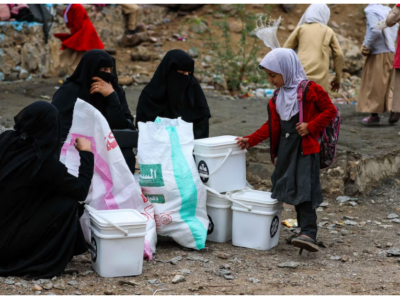
“Pause.” Flickr user Pierre (CC BY 2.0)
Hello GV community! We are announcing an upcoming “pause” or hiatus related to the NewsFrames project. The pause is both necessary and strategic — for those of you following the project since the beginning in 2016, you may know that our Google DNI grant comes to an end in the next month.
From the beginning, NewsFrames has been an attempt to figure out if we could use data-related media tools to support GV’s mission of “find[ing] the most compelling and important stories coming from marginalized and misrepresented communities,” partly by offering a resource that helps measure what misrepresentation in media might mean.
Leveraging cutting-edge technologies has meant experimenting and trying to figure out how to bring together technological innovation with the interests and capacity of the Global Voices community at large. We've found that these efforts have resonated more with the Rising Voices and Lingua communities.
For a number of reasons, we believe that instead of forging directly ahead, it would be wiser to use this moment to pause and take stock. Which is why though we did pursue a few funding avenues to continue the work, we have not approached it with full intensity. This gives us a chance to think about the NewsFrames project as it has developed in conjunction with the mission of Global Voices, and to figure out the future development path that makes the most sense.
In this post, we’re sharing some of our reflections as well as some ideas we have as a team before saying goodbye for now to our formal roles. In another post we'll share our ideas on what a future “re-boot” of the project might look like. In addition to these reflections, we will be hosting a series of real-time hangouts in the next month so that we can gather NewsFrames community feedback for the next imagining.
A project like NewsFrames could not have evolved anywhere else as it has at Global Voices, and we'd like to thank all who participated for being part of this first phase.
NewsFrames is about learning and exploration
![]() Iria Puyosa, Team Lead: When I first learned about NewsFrames via a community email from [Rising Voices Director] Eddie Avila, I was excited about the project's potential to revamp media analysis approaches, especially at a time when we are in the middle of a global attention peak about disinformation. In the end, I feel glad I have been a part of this project. It has been a learning experience. And, for me, knowledge sharing is what gives meaning to life. Learning how to work on developing media analysis tools and collaborative journalism spaces has been worthy of my time and attention.
Iria Puyosa, Team Lead: When I first learned about NewsFrames via a community email from [Rising Voices Director] Eddie Avila, I was excited about the project's potential to revamp media analysis approaches, especially at a time when we are in the middle of a global attention peak about disinformation. In the end, I feel glad I have been a part of this project. It has been a learning experience. And, for me, knowledge sharing is what gives meaning to life. Learning how to work on developing media analysis tools and collaborative journalism spaces has been worthy of my time and attention.
Nevin Thompson, Engagement Lead: I also think that NewsFrames has been of value to the Global Voices (GV) community. The project has provided the chance, to people from all over the world, to learn new skills and explore how issues are represented in local media. The project has also facilitated self-actualization — an important part of volunteer-run communities — by providing previous non-specialists with ways to participate in the discipline of media analysis, and, in some cases, find opportunities to become experts in this field.
Belen Febres-Cordero, Team Lead: Yes, from my perspective, one aspect that NewsFrames has promoted in particular is in-depth analysis. NewsFrames has provided the opportunity to deeply explore topics of interest. Through different media analysis tools, we have seen the way that certain topics are being shaped in the media, and we have explored the meanings that these frames might have. This has added another layer of interpretation to the news that we cover and write about, and has allowed us to further understand the context of each story.
The tools and methods developed by NewsFrames have created an opportunity to foster self-reflection, to take a look at our own coverage as well. NewsFrames has allowed us to analyze both the content that we are producing and the content produced by other media. In this way, we have been able to find the ways in which we might differentiate ourselves from other media outlets. We have only just begun to understand how this process can transform the work that we do, to provide us with insights that could help us shape our stories to make sure that the content that we are producing and sharing is aligned with our objectives and values.
But this kind of media analysis can be challenging for GV
![]() Andrea Chong Brás, Editing Lead: NewsFrames has provided the community with an opportunity to really examine the way that the media shapes our understanding of events — on both subtle and overt levels. Media analysis can be challenging for new writers (or even more experienced journalists) who might not be accustomed to the rigorous editing process that working with data-driven storytelling can entail. Our writers might see a story in the data that simply isn't there or they might not see any pieces that are worth building on.
Andrea Chong Brás, Editing Lead: NewsFrames has provided the community with an opportunity to really examine the way that the media shapes our understanding of events — on both subtle and overt levels. Media analysis can be challenging for new writers (or even more experienced journalists) who might not be accustomed to the rigorous editing process that working with data-driven storytelling can entail. Our writers might see a story in the data that simply isn't there or they might not see any pieces that are worth building on.
It is at this point where I feel that our strength as a team shines through, especially when it comes to the work that NewsFrames leads like Belen, Nevin, Connie, and Iria do to develop stories alongside the contributors. Because the NewsFrames writing and editorial process stretches over a longer time frame, NewsFrames leads are able to spend time teaching our contributors how to work with data to create a polished piece. This means that it is truly a learning experience for any contributor that is interested in professional development as a writer, a researcher or just as a curious person.
That process, for some, might mean experiencing the frustration of having to be more thorough and conscious than usual of the words that we use to illustrate what the data is trying to tell us and specifically shying away from any language that might denote things that the data is simply not strong enough to imply. But this attention to detail can also be seen as a strength because it forces contributors, NewsFrames leads, and the editorial team to really analyze the language that we are employing to communicate ideas, helping us to address our own biases along the way.
Connie Moon Sehat, Director: All true. In addition, I think that NewsFrames has offered a home to GV discussions about the nature of media representation, media literacy, and information quality on the internet. But this can be very “meta.”
These conversations and work have long been a main aspect of GV, of course, with long reporting on the disinformation efforts in Advox, or the misrepresentation and lack of access of indigenous people to the web in Rising Voices.
But NewsFrames went a step further, through the Fabricated News Experiment, or the Picture Worth a Thousand Wrong Words story, or the Reframed Story series in Ecuador. These efforts tried to model what truly collective efforts might look like.
In addition, we do talk about the nature of knowledge, of bias, of framing. It can be a bit abstract. But I think it's a question if this is something that GV continues to want a dedicated space for?
Iria: To bring it back to everyday reporting, I think that moving to a data-driven reporting model would be a leap into the future for GV. This transformative idea may cause uncertainty and resistance. The adoption of a data-driven model may be easier in the extended communities of the Rising Voices and Advox projects.
In my mind, NewsFrames is an innovative project — a project that puts GV in the middle of an emerging conversation where there are no established rules. That can create a feeling of disruption in a community where there is a strong tradition of a type of consensus where the ability to have productive disagreement hasn't been fostered enough. I think an organization that prides itself on both strengthening internal ties and crystallizing traditions has to suffer when trying to innovate. Incubating a project, developing tools, and experimenting with formats is challenging. Testing tools, developing tutorials, and shaping mentorship processes are time-consuming and expensive, and these outputs may go unnoticed within an organization used to measuring success by post numbers.
Continued focus on collaboration has to be part of the way forward
Andrea: I think NewsFrames also welcomes collaborative posts. Indeed, even if the post is written by one person, the process is very collaborative from start to finish. There are many people who get their hands on each piece before it eventually sees the light of day and that brings diversity to the storytelling process while also making sure that no individual's bias is allowed to dominate the post.
Belen: Yes, probably the most important contribution that NewsFrames offers is its collaborative component. Each story in this project is a result of the combination of the ideas and the input of several people. This collaboration takes place on multiple platforms and in all parts of the process, from the development of a story idea to its publication. This allows us to combine the strengths of several people to create high-quality content and to live by and strengthen the community focus that Global Voices strives for.
Connie: I think we got the “collaborative media analysis” right, but we initially designed the tool primarily for authors. We should have aimed for explorers instead, which is what we shifted towards once we figured this out.
Trying to practice media analysis using data is not something that is easy to do on one’s own. Not many people have the ability to both crunch data (numbers! spreadsheets!) and apply particular country expertise that can impact the interpretation of information, not to mention the additional skills of authoring, editing, and translating required to communicate the findings well and broadly. And in fact, whether it has to do with large-scale database analysis or not, there is a lot of collaboration that goes into general GV story creation. So we figured correctly from the outset that we were going to have to create a collaborative working space.
But in our initial attempts, our efforts were about seeing a published story as the most desired outcome. While stories are critical outcomes, one of the things that authors know is that every idea or attempt doesn’t always translate into a written work. This is all the more so when it comes to work that relates to discovery — we are talking about an area in which “we do not know what we do not know.”
Questions can be more important than the answers that you can find (as in all these starting explorations i.e. when Andrea explored with new NewsFrames volunteer Sarah Morris how media talks about teens; when Belen explored how media talks about women; when Sana [Saleem, former NewsFrames Team Lead] investigated how outlets, including GV, report on Pakistan). Sometimes you can be surprised (as in Nevin's explorations around conversations related to Sex and Japan) but sometimes as Iria wrote, the data just isn’t there.
It is an achievement to enter into a space driven by curiosity and start asking questions. You may find some answers but more importantly, you begin to face limits to your own knowledge. This is what we tried to do in our recent exploration guidelines.
Nevin: I think there needs to be a range of activities for volunteers. We discovered that potential volunteers can be scared off by the prospect of learning how to conduct media analysis. As a result, it is important to develop a range of meaningful activities — including developing story types with a range of complexity — to encourage participation and build community. This is why translation and media list development became important.

“Pause.” Flickr user Jeff Gill (CC BY-NC-ND 2.0)
Communication is sometimes harder to have within GV than beyond it
Nevin: NewsFrames has been embraced by a critical mass of the GV community Lingua translators, as well as the Rising Voices community, who have shown a lot of interest in NewsFrames and form the core of the nascent NewsFrames community. At the moment, there are about 100 people on our mailing list and there is continuing interest in attending hangouts and participating in various ways.
As a new project, some may still be unaware of all that NewsFrames has accomplished since 2016, but we have enjoyed engagement with those who we have had the opportunity to chat with us thus far.
Iria: There were challenges that I encountered as a part of the NewsFrames team. The major challenge was trying to learn how “to sell” the project to the GV community. Every time I presented NewsFrames to people in different venues outside of Global Voices (e.g. my communication researchers colleagues, political consultants, social activists), they got excited about the tool capabilities and the overall potential for understanding information disorders as well as media framing. But when I presented the project to GV editors and authors, some responses I received were along these lines: “I don't understand what NewsFrames is,” “This is very different from the way we normally work,” “It is difficult and it takes a lot of time,” “I don't see the point of analyzing the media if we already know that they manipulate,” “Your results do not take into account the context.” Initially, that sort of response was very discouraging. NewsFrames seemed always to speak fluently with those outside and had difficulty conversing with those inside.
After the Summit, we changed our outreach approach. I think it worked better. People within the GV community started to reach out to us with different interests about getting value from NewsFrames tools and methods. Some people wanted to try the tools for instrumental reasons, or they saw value in learning media analysis. Others were interested in fostering their activist agendas and they saw value in obtaining data to back their claims. There were others that just found it fun to explore data and underlying issues. I feel that it is just now that NewsFrames is starting to gain momentum. It would have been great if we would have achieved this five months ago.
Belen: Speaking of outside engagement, NewsFrames also collaborates with Rising Voices to empower under-represented communities and misrepresented communities to make their voices heard online. The tools and methods developed by NewsFrames have been shared with people outside GV, particularly with marginalized, underrepresented and misrepresented communities from different parts of the world.
This has allowed these communities to explore some of the topics that are relevant to them, and to see how they are being represented, or not, by the media. In addition, we offer them the opportunity to respond to this coverage from their own perspectives by inviting them to publish articles or posts in which they explain their views about the coverage that they interpreted. In this way, we are contributing to efforts which raise the voices of these communities, while also strengthening their mission of self-representation. This also allows them to analyze, reconsider and shape their communication strategies and messages. People who have participated in the project have told us that the NewsFrames tools and methods can complement the efforts of indigenous and other underrepresented and misrepresented communities, connecting and that it can connect communities facing similar struggles from different parts of the world so that they can share experiences and ideas geared towards self-representation.
Nevin: NewsFrames has also raised GV's profile in other global communities. Since blogging and to some extent even websites have been replaced by proprietary social media platforms, it's been increasingly difficult for GV to remain part of the conversation, save for digital rights and advocacy. By developing tools for and providing opportunities to analyze representation and misinformation, I feel that NewsFrames has provided GV with the chance to participate and, in some cases lead, a global conversation about these issues.
While such work is intrinsically good, from GV's point of view there are also practical benefits. By demonstrating relevance and a commitment to innovation, GV can also remain in discussion with funders about the future of the organization. Thanks also to Google DNI funding, NewsFrames has provided GV with short-term capacity-building and contributions to the overhead cost of Global Voices.
Facilitating a community to write NewsFrames stories requires a lot of support
Nevin: NewsFrames will require significant resources to continue to grow. At the end of “version 1″, NewsFrames has been a success. There is a robust online platform that integrates a variety of software tools and checklists, and there is a critical mass of volunteer community members who write and translate stories, participating in a variety of ways in NewsFrames. GV is in a good place to launch “Version 2″, or a second stage of the project.
However, all of this has required significant staff resources to not only build and refine the platform but to engage the community of volunteers interested in exploring framing, representation and media analysis. NewsFrames’ success so far has depended on paid contractors specializing in strategy, software development management, media analysis, data science, community engagement, curriculum design and documentation, facilitation, journalism best practices and other disciplines.
As we pause at “Version 1″ there is indeed the critical mass of engaged volunteers needed to discuss, collaborate, analyze, think, write, translate and do any number of community activities. However, there is still work to be done to continue to grow the community — and that work requires paid staffers.
Connie: One way that I put it is like this: the support of data tool development and analysis across multiple time zones takes a village. It also requires a dedicated team of extra staff.
Creating a long-term space for this kind of work is a question of resources and overall organizational mission. To engage in exploration about the theme of media representation is to become conversant in new vocabularies and new modes of work. In order to write about Standing Rock, for example, one may have to learn about why the use of terms like protester versus protector matters in addition to what sampling and Natural Language Processing mean. To translate a NewsFrames post, you may have to also wrestle with “framing” or a “Culture Shot” which introduces the complicated multilayered metaphorical terms that our Lingua folks grapple with every day in order to promote broader understanding. You also need designers and coders to build user-friendly software.
But the community and the field is changing all the time, so you need to approach it in the style of building a layered cake — a little at a time, with room to evolve.
Added to this are evolving standards of writing stories that use data, or data journalistic practices. Doing all this — creating resources that can support this kind of exploration — requires extra processes and practices that GV hasn’t had to staff for before.

“Pause.” Flickr user Roberto Saltori (CC BY-NC 2.0)
It's tough to launch new projects within GV, but when it happens, there can be great benefits
Nevin: As I understand it, one of the initial goals of the project was to build a tool or service that would eventually generate revenue for GV. This has been tough to achieve for a number of different reasons. Structurally, GV may not be equipped to deal with the risk of commercializing a product or a service.
It has also been challenging to develop the consensus needed to launch such a stand-alone service. NewsFrames has raised questions not only about GV's purpose and goals, but also about who gets to decide what GV's goals are, and what strategies will be used to achieve those goals.
While building consensus among the GV community is key, there is also a need to clearly articulate the value that NewsFrames holds for GV. The project is successful in that the community is engaged and there are meaningful project outputs — GV is participating in the current global conversation about (mis)representation, and it's participating in a way that remains true to GV's historical goals of reporting, translating, connecting and empowering voices from around the globe.
Connie: To go a bit further, yes it's tough. But Global Voices seems to have this amazing ability to incubate creative processes and approaches that support an internet for all. This is a great service.
NewsFrames has been an opportunity to take seriously the challenges of diverse cultures, ethics, and truth in reporting — through the lens of data — all while having a lot of fun and joy in between.
If you don’t know the members of the GV NewsFrames team, introduce yourselves! In addition to lending their voice and thoughts to the shape of the NewsFrames initiative, they are a very welcoming and super insightful bunch!
Our work has led to wonderful attention: we’ve been invited to submit materials for an internet prize, for example, or to discuss this work in classrooms from Texas to Hong Kong and conferences all around the world including the upcoming RightsCon. And in the tradition of other projects that GV has incubated or spun off (Witness Hub, Transparency for Technology Network), we also believe there can be a long-term benefit for NewsFrames, even beyond GV. To support this, we released the NewsFrames platform code under the Apache 2.0 license this week.
This is why I think that regardless of NewsFrames’ long-term fit or development for GV, promoting collaborative media analysis around representation has been a worthy effort. An effort along the lines of the kind of bridge-building internet that GV has tried to support from its inception. There are many tools for this kind of analysis in the hands of corporations and private enterprises. But I think that encouraging this access and capacity specifically for civil society analysis is important in the days ahead as the infrastructure of the internet continues to be shaped in the wake of the misinformation and disinformation challenge.
Read next >> Pressing ‘Play’ on NewsFrames



